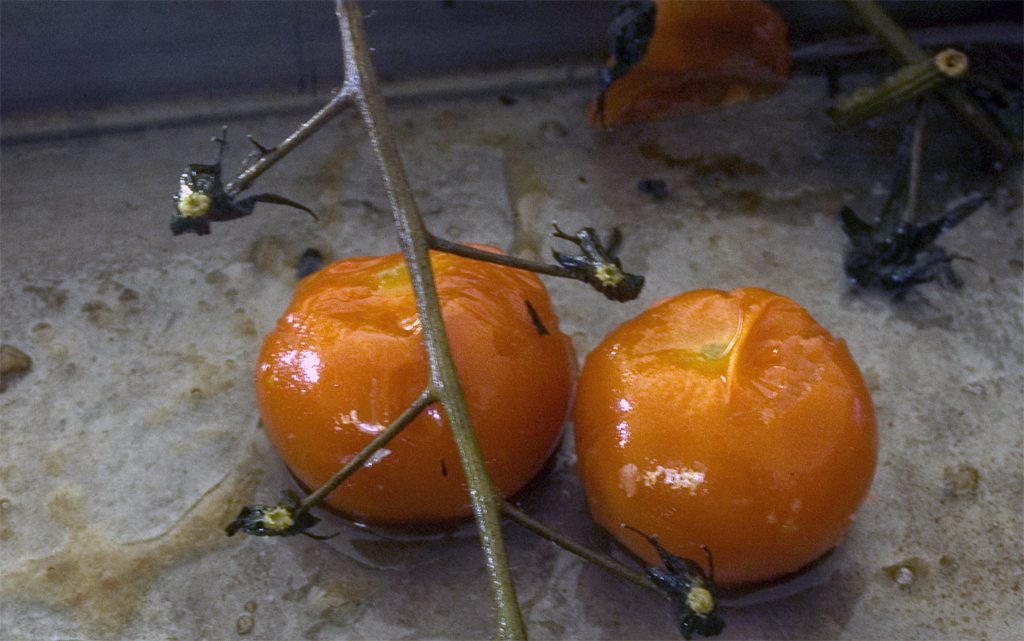“I don’t know, zhey are my grandfather’s”, was the reply, in an Australianised eastern European accent. The stare was intent and piercing as the expectation of my next words consumed this most unlikely of characters. There was silence; uneasy, but necessary. I then looked him in the eye as my head oscillated; a left turn and then a right.
“Unbelievable. Just unbelievable. Umami”
“My name is Nicolaos, not Umami. Is everything ok?”
“Oh just fantastic” I said. “I cannot believe the flavour and taste in these – the umami, the taste, around the mouth is incredible” I continued whilst gesticulating madly in a very Gallic manner.
It was just a nondescript stall in a farmers market, with a mountain of tomatoes and a price. No business card, no business name displaying the purveyor or even a brochure to explain what variety of tomatoes they were. The only clue was a discreet sign that read “Grandpa’s tomatoes”. Yet, this understated stall was making its mark on this culinary aficionado. As I found out from an awkward, yet friendly, conversation these tomatoes had only ever been known as Grandpa’s tomatoes, having been grown in Australia for two generations since being plucked from the rolling hills of Macedonia. They were large, soft and ripe, and had an incredible savoury taste sensation in the mouth. I really had discovered umami and wanted to know more.
The umami discovery took me to a darkened land, a place that is still taboo amongst those that want to believe it. But it’s a land that is not as bad as it has historically been reported, and has only been darkened by one less than rigorous scientific study; and this place? It’s called Glutamic acid, an amino acid which is more commonly known in its concentrated form as monosodium glutamate (MSG). As legend goes, Japanese chemist Kikunae Ikeda was investigating the properties of dried konbu and its surface crystals back in old Tokyo of 1908 when he isolated the glutamate molecule. He marvelled at its unique savoury, taste sensation and decided that it was distinctly different from the then four accepted tastes of sweet, sour, bitter and salty. And by that decree named this new sensation umami, which roughly translates as ‘delicious’.
Scepticism was rife for many years about this new taste, and as a consequence it was dismissed as a new ‘taste’ sense. However, in 2001 scientists discovered the umami receptor on the tongue and it is now accepted as the fifth taste. Since its discovery in 1908, two other umami substances have been found; inosine monophosphate, which was first discovered in cured skipjack tuna, and guanosine monophosphate, which was isolated in shiitake mushrooms. It was found that the three umami substances worked in synergy together to enhance the flavour of food. The value when cooking is that umami rich foods containing different umami substances when brought together magnify the taste providing the cook/ chef with fantastic possibilities.
One year after Ikeda’s discovery, MSG was developed commercially and used to enhance or introduce the umami flavour in many foods. The 1960s was when the dreaded ‘Chinese Restaurant Syndrome’ was coined, and MSG was isolated as the main culprit. Apparently, the effects of consuming MSG were headaches, chest pains, heart palpitations and burning on the skin. The mystery is that many properly controlled scientific tests since have found no evidence of these effects, and moreover the same molecule in MSG is that which contributes to the magic of Parmesan cheese, potatoes, anchovies, fish sauce, mushrooms, olives, tuna, squid, prawns, soy sauce and of course Grandpa’s tomatoes.
Personally, I have never cooked with pure MSG as a flavour enhancer, simply because I try and use ingredients and produce that contains it naturally. I have no qualms in adding it to a dish from a health perspective, and I had been in the anti-MSG camp for many years until I started to understand more about it, but I think the test of a cook’s or chef’s mettle is to be able to cleverly craft ingredients without needing to add it. I think umami is sensational, but it is sad how commercial MSG is being used to create quick, cheap and often inferior food. In her book on Szechuan cooking, Land of Plenty, Fuschia Dunlop writes:
It is a bitter irony that in China of all places, where chefs have spent centuries developing the most sophisticated culinary techniques, this mass-produced white powder should have been given the name wei jing, ‘the essence of flavour’.
As for my journey with umami, that continued as I took home one of Grandpa’s very large tomatoes, cut it up into bite sized pieces and just ate it au naturel, with a nice crusty pane di casa. Taste and simplicity personified.
Just as an aside, roast some dried shiitake mushrooms for about ten minutes in a medium hot oven, grind them to a powder, and use as an umami seasoning for soups and steak; the flavour enhancement is quite super.




